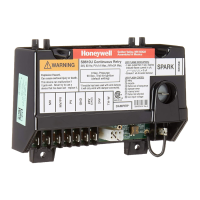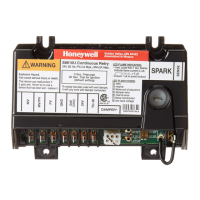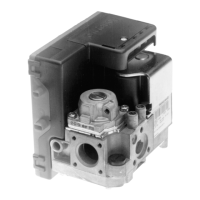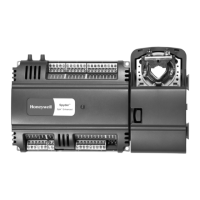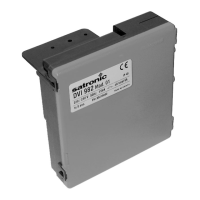S8600B,C,H,M; S8610B,C,H,M; S8670D,E,J,K INTERMITTENT PILOT GAS IGNITION CONTROL
บริษัท เอดีดี เฟอร์เนส จํากัด
ADD FURNACE CO.,LTD.
44 ซอยบรมราชชนนี 70 ถนนบรมราชชนนี แขวงศาลาธรรมสพน์ เขตทวีวัฒนา กรุงเทพฯ 10170
โทร: 02-888-3472 โทร: ออกแบบ:08-08-170-170 แฟกซ์: 02-888-3258
https://www.add-furnace.com E-mail: sales@add-furnace.com
IMPORTANT
1.
The following service procedures are provided
as a general guide. Follow appliance manufac-
turer’s service instructions if available.
2.
Meter readings between the gas control and igni-
tion control must be taken within the trial for igni-
tion period. Once the ignition control shuts off,
lockout models must be reset by setting the ther-
mostat down for at least 30 seconds before con-
tinuing. On retry models, wait for retry or reset at
the thermostat.
3.
If any component does not function properly,
make sure it is correctly installed and wired
before replacing it.
4.
The ignition module cannot be repaired. If it mal-
functions, it must be replaced.
5.
Only trained, experienced service technicians
should service intermittent pilot systems.
6.
After troubleshooting, check out the system
again to be sure it is operating normally.
General troubleshooting process is as follows:
1.
Refer to “LED Status and Troubleshooting” on
page 12 for LED status codes.
2.
Perform the “Checkout” on page 7 as the first step
in troubleshooting.
3.
Check the troubleshooting guide (Fig. 14) to pin-
point the cause of the problem.
4.
If troubleshooting indicates an ignition problem, see
Ignition System Checks below to isolate and correct
the problem.
5.
Following troubleshooting, perform the “Checkout”
on page 7 again to be sure system is operating nor-
mally.
Ignition System Checks
Step 1: Check ignition cable.
Make sure:
•
Ignition cable does not run in contact with any metal
surfaces.
•
Ignition cable is no more than 36 in. (0.9 m) long.
•
Connections to the ignition module and to the igniter or
igniter-sensor are clean and tight.
•
Ignition cable provides good electrical continuity.
STEP 2: Check ignition system
grounding. Nuisance shutdowns are
often caused by a poor or erratic
ground.
A common ground is required for the module and the pilot
burner bracket.
•
Check the ground circuit from the
GND(BURNER) terminal on the module to the
pilot burner. Make sure connections are clean
and tight. If the wire is damaged or
deteriorated, replace it with 14- to 18-gauge,
moisture-resistant, thermoplastic insulated wire
with 221°F (105°C) minimum rating.
— If the flame rod or bracket is bent out of
position, restore to correct position.
STEP 3: Check spark ignition circuit.
You will need a short jumper wire made
from ignition cable or other heavily
insulated wire.
•
Close the manual gas valve.
•
Disconnect the ignition cable at the SPARK terminal on
the module.
WARNING
Electrical Shock Hazard.
Can cause severe injury, death or property damage.
When performing the following steps, do not touch
the stripped end of jumper or SPARK terminal.
The ignition circuit generates over 10,000 volts
and electrical shock can result.
•
Energize the module and immediately touch one end
of the jumper firmly to the GND terminal on the
module. Move the free end of the jumper slowly toward
the SPARK terminal until a spark is established.
•
Pull the jumper slowly away from the terminal and note
the length of the gap when sparking stops. Check
Table 5 below.
Table 5. Arc Troubleshooting.
No arc or arc less
than 1/8 in. (3 mm)
Check external fuse, if provided.
Verify power at the module’s input
terminal. Replace control if fuse and
power are okay.
Arc 1/8 in.(3 mm)
or longer
STEP 4: Check pilot and main burner
lightoff.
•
Set the thermostat to “Call for Heat.”
•
Watch the pilot burner during the ignition sequence.
See if:
•
Ignition spark continues after the pilot is lit.
•
The pilot lights and the spark stops, but main
burner does not light.
•
S8600 B,H; S8610 B,H; S8670 D,J only: The
pilot lights, the spark stops and main burner
lights, but the system shuts down.
•
If so, ensure adequate flame current as follows.
•
Turn off appliance power at circuit breaker or
fuse box.
•
Clean the flame rod with emery cloth.
•
Make sure electrical connections are clean and
tight. Replace damaged wire with moisture-
resistant No. 18 wire rated for continuous duty
up to 221°F (105°C).
•
Check for cracked ceramic insulator, which can
cause short to ground, and replace igniter-
sensor if necessary.
•
At the gas control, disconnect main valve wire
from the MV terminal.
•
Turn on power and set thermostat to call for
heat. The pilot should light but the main burner
will remain off because the main valve actuator
is disconnected.
•
Check the pilot flame. Make sure it is blue,
steady and envelops 3/8 to 1/2 in. (10 to 13
mm) of the flame rod. See Fig. 11 for possible
flame problems and their causes.

